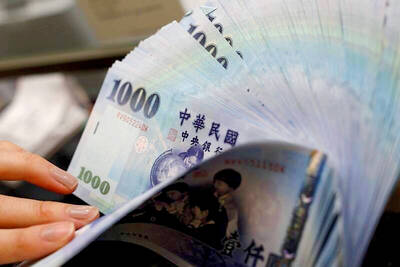Taiwan Semiconductor Manufacturing Co (TSMC, 台積電), the world’s largest contract chipmaker, yesterday said it was likely to increase capital spending again this year from a record-high of US$4.8 billion to match the pace of a faster-than-expected recovery in demand for electronics products across the board.
TSMC started increasing capital expenditures in September last year when it detected that a swift rebound was causing capacity constraints, bringing last year’s capital spending to US$2.7 billion in total, almost double the originally planned US$1.5 billion, chairman Morris Chang (張忠謀) told a TSMC technology symposium in Hsinchu.
“This is a dramatic move,” Chang said.
In January, TSMC said it planned to expand capital spending by about 77 percent year-on-year to US$4.8 billion this year to meet growing demand.
“We are still in the process of accelerating our capital spending. I’m afraid the figure will exceed the budgeted US$4.8 billion,” Chang said.
He declined to reveal how much the increase could be.
In April, the company told investors that demand had surpassed what it could supply by 30 percent to 40 percent in terms of chips made on advanced technologies.
“Given tight foundry capacity in the near-term and the longer lead-time at fabless companies this year, some companies who didn’t plan their capacity allocation well will suffer loss of market share,” Jonah Cheng (程正樺), a chip industry analyst with UBS Securities Pte Ltd’s Taiwan branch, told a media briefing yesterday in Taipei.
It will be TSMC’s strategy to have 10 percent to 15 percent more capacity than orders require, as that would allow the chipmaker to have the ability to cope with any unexpected increase in demand, Chang said.
He said that, along with its customers, TSMC would take 20 percent of the US$260 billion global chip market this year by enhancing the business model invented 20 years ago by the company — TSMC focused on making chips, while its customers sold products that they powered.
“I think IDMs [integrated device manufacturers] have plans to reduce research and development spending, as well as capital expenditure,” Chang said in response to a reporter’s question about whether IDMs had increased the pace of outsourcing to contract chipmakers.
Separately, local chip tester and packager Siliconware Precision Industries Co (矽品精密) yesterday raised its spending on new equipment by about 45 percent to NT$21 billion (US$654 million) from NT$14.3 billion to NT$14.5 billion previously planned.
The expansion was bigger than the 30 percent increase the company announced earlier this month, almost four times the NT$5.5 billion it spent last year.

Merida Industry Co (美利達) has seen signs of recovery in the US and European markets this year, as customers are gradually depleting their inventories, the bicycle maker told shareholders yesterday. Given robust growth in new orders at its Taiwanese factory, coupled with its subsidiaries’ improving performance, Merida said it remains confident about the bicycle market’s prospects and expects steady growth in its core business this year. CAUTION ON CHINA However, the company must handle the Chinese market with great caution, as sales of road bikes there have declined significantly, affecting its revenue and profitability, Merida said in a statement, adding that it would

MARKET LEADERSHIP: Investors are flocking to Nvidia, drawn by the company’s long-term fundamntals, dominant position in the AI sector, and pricing and margin power Two years after Nvidia Corp made history by becoming the first chipmaker to achieve a US$1 trillion market capitalization, an even more remarkable milestone is within its grasp: becoming the first company to reach US$4 trillion. After the emergence of China’s DeepSeek (深度求索) sent the stock plunging earlier this year and stoked concerns that outlays on artificial intelligence (AI) infrastructure were set to slow, Nvidia shares have rallied back to a record. The company’s biggest customers remain full steam ahead on spending, much of which is flowing to its computing systems. Microsoft Corp, Meta Platforms Inc, Amazon.com Inc and Alphabet Inc are

RISING: Strong exports, and life insurance companies’ efforts to manage currency risks indicates the NT dollar would eventually pass the 29 level, an expert said The New Taiwan dollar yesterday rallied to its strongest in three years amid inflows to the nation’s stock market and broad-based weakness in the US dollar. Exporter sales of the US currency and a repatriation of funds from local asset managers also played a role, said two traders, who asked not to be identified as they were not authorized to speak publicly. State-owned banks were seen buying the greenback yesterday, but only at a moderate scale, the traders said. The local currency gained 0.77 percent, outperforming almost all of its Asian peers, to close at NT$29.165 per US dollar in Taipei trading yesterday. The

The US overtaking China as Taiwan’s top export destination could boost industrial development and wage growth, given the US is a high-income economy, an economist said yesterday. However, Taiwan still needs to diversify its export markets due to the unpredictability of US President Donald Trump’s administration, said Chiou Jiunn-rong (邱俊榮), an economics professor at National Central University. Taiwan’s exports soared to a record US$51.74 billion last month, driven by strong demand for artificial intelligence (AI) products and continued orders, with information and communication technology (ICT) and audio/video products leading all sectors. The US reclaimed its position as Taiwan’s top export market, accounting for